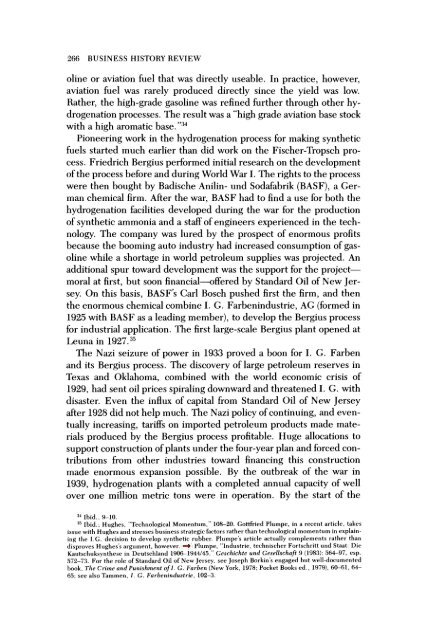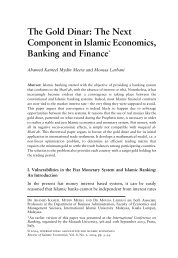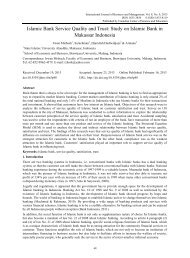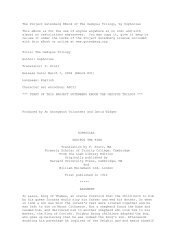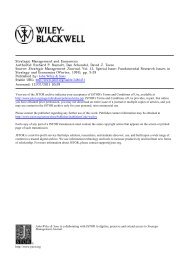The Oil Industry in Nazi Germany, 1936-1945
The Oil Industry in Nazi Germany, 1936-1945
The Oil Industry in Nazi Germany, 1936-1945
Create successful ePaper yourself
Turn your PDF publications into a flip-book with our unique Google optimized e-Paper software.
266 BUSINESS HISTORY REVIEW<br />
ol<strong>in</strong>e or aviation fuel that was directly useable. In practice, however,<br />
aviation fuel was rarely produced directly s<strong>in</strong>ce the yield was low.<br />
Rather, the high-grade gasol<strong>in</strong>e was ref<strong>in</strong>ed further through other hy-<br />
drogenation processes. <strong>The</strong> result was a "high grade aviation base stock<br />
with a high aromatic base. "34<br />
Pioneer<strong>in</strong>g work <strong>in</strong> the hydrogenation process for mak<strong>in</strong>g synthetic<br />
fuels started much earlier than did work on the Fischer-Tropsch pro-<br />
cess. Friedrich Bergius performed <strong>in</strong>itial research on the development<br />
of the process before and dur<strong>in</strong>g World War I. <strong>The</strong> rights to the process<br />
were then bought by Badische Anil<strong>in</strong>- und Sodafabrik (BASF), a Ger-<br />
man chemical firm. After the war, BASF had to f<strong>in</strong>d a use for both the<br />
hydrogenation facilities developed dur<strong>in</strong>g the war for the production<br />
of synthetic ammonia and a staff of eng<strong>in</strong>eers experienced <strong>in</strong> the tech-<br />
nology. <strong>The</strong> company was lured by the prospect of enormous profits<br />
because the boom<strong>in</strong>g auto <strong>in</strong>dustry had <strong>in</strong>creased consumption of gas-<br />
ol<strong>in</strong>e while a shortage <strong>in</strong> world petroleum supplies was projected. An<br />
additional spur toward development was the support for the project-<br />
moral at first, but soon f<strong>in</strong>ancial--offered by Standard <strong>Oil</strong> of New Jer-<br />
sey. On this basis, BASF's Carl Bosch pushed first the firm, and then<br />
the enormous chemical comb<strong>in</strong>e I. G. Farben<strong>in</strong>dustrie, AG (formed <strong>in</strong><br />
1925 with BASF as a lead<strong>in</strong>g member), to develop the Bergius process<br />
for <strong>in</strong>dustrial application. <strong>The</strong> first large-scale Bergius plant opened at<br />
Leuna <strong>in</strong> 1927.35<br />
<strong>The</strong> <strong>Nazi</strong> seizure of power <strong>in</strong> 1933 proved a boon for I. G. Farben<br />
and its Bergius process. <strong>The</strong> discovery of large petroleum reserves <strong>in</strong><br />
Texas and Oklahoma, comb<strong>in</strong>ed with the world economic crisis of<br />
1929, had sent oil prices spiral<strong>in</strong>g downward and threatened I. G. with<br />
disaster. Even the <strong>in</strong>flux of capital from Standard <strong>Oil</strong> of New Jersey<br />
after 1928 did not help much. <strong>The</strong> <strong>Nazi</strong> policy of cont<strong>in</strong>u<strong>in</strong>g, and even-<br />
tually <strong>in</strong>creas<strong>in</strong>g, tariffs on imported petroleum products made mate-<br />
rials produced by the Bergius process profitable. Huge allocations to<br />
support construction of plants under the four-year plan and forced con-<br />
tributions from other <strong>in</strong>dustries toward f<strong>in</strong>anc<strong>in</strong>g this construction<br />
made enormous expansion possible. By the outbreak of the war <strong>in</strong><br />
1939, hydrogenation plants with a completed annual capacity of well<br />
over one million metric tons were <strong>in</strong> operation. By the start of the<br />
34 Ibid., 9-10.<br />
:3. Ibid.; Hughes, "Technological Momentum," 108-20. Gottfried Plumpe, <strong>in</strong> a recent article, takes<br />
issue with Hughes and stresses bus<strong>in</strong>ess strategic factors rather than technological momentum <strong>in</strong> expla<strong>in</strong>-<br />
<strong>in</strong>g the I.G. decision to develop synthetic rubber. Plumpe's article actually complements rather than<br />
disproves Hughes's argument, however. See Plumpe, "Industrie, technischer Fortschritt und Staat: Die<br />
Kautschuksynthese <strong>in</strong> Deutschland 1906-1944/45," Geschichte und Gesellschaft 9 (1983): 564-97, esp.<br />
572-73. For the role of Standard <strong>Oil</strong> of New Jersey, see Joseph Bork<strong>in</strong>'s engaged but well-documented<br />
book, <strong>The</strong> Crime and Punishment ofl. G. Farben (New York, 1978; Pocket Books ed., 1979), 60-61, 64-<br />
65; see also Tammen, I. G. Farben<strong>in</strong>dustrie, 102-3.


